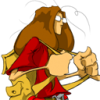I am doing some very simple raytracing
I want to get some experiments and get knowledge in the fundamentals
[attachment=19828:ball.jpg]
the result is not impressive, I noticed it before that simple setting the light
as a cosinus of normal to surface and light direction (I used here) give some
'plastic' looking lightning
there are also big topics:
i would like to define material color (as 3 floats from 0..1)
I would like to define light color (as 3 floats from 0..1)
how to calculate the resulting color (also as 3 floats from 0..1)
how to add more lights lightning the same point?
should i invite some open float (0 to more than 1) as a color value
then map it with some transformation to 0..1 ?






